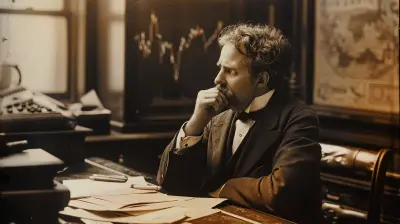What Crowdfunding Teaches Us About Market Validation
10 November 2025
Have you ever had a killer idea and thought, “This is it! This could change the game.” But then, just before diving in, that little voice in your head popped up—what if nobody wants it?
That’s where crowdfunding swoops in like a superhero in startup land. Not only does it help fund your dream, but here's the real kicker—it doubles as a crystal-clear test of whether the market actually wants what you're offering. Yep, crowdfunding is one of the best real-world lessons in market validation, and in this article, we're unpacking exactly why.
Whether you're a budding entrepreneur, a creative thinker, or just someone who's intrigued by how businesses take shape, you’re going to want to stick around. Let's dive into what crowdfunding can really teach us about launching the right product to the right people.
What Is Crowdfunding, Really?
Let’s break it down super simple.Crowdfunding is when you raise small amounts of money from a large number of people—usually online. Platforms like Kickstarter, Indiegogo, and GoFundMe are the usual suspects here. People (aka “backers”) chip in because they believe in your idea, not because they’re buying stock or expecting a financial return (though sometimes they get cool perks or early access).
But here’s the fringe benefit: it’s not just about cash. It’s about feedback, engagement, and validation. It's a proving ground nestled inside a money-raising vehicle.
The Crowdfunding-Market Fit Connection
So, why does crowdfunding tell you so much about market validation? Because it's a real-time experiment in product-market fit.You put your idea out there, maybe with a prototype, a short video, and some compelling copy. Then, you sit back and watch what the market does.
Does it catch fire? Do people whip out their credit cards and support you?
Or does it flop, falling flat with zero momentum?
The answer gives you powerful insights. Real dollars, real decisions, real data. You can't get that from a survey or a focus group. This is raw, unfiltered market response.
Crowdfunding as a Pre-Launch Simulator
Think of crowdfunding like a flight simulator for entrepreneurs.- You get to “test fly” your product in the real world without fully launching.
- You learn how people respond to the design, price, message, and value proposition.
- You get feedback before you spend months (or years!) building the wrong thing.
Most successful product launches these days aren’t about “build it and they will come.” They’re about “test it, tweak it, and launch only when people are banging down the door asking for it.”
That’s the essence of market validation—and crowdfunding brings that to life.
Real Talk: Why Traditional Market Research Isn’t Enough
Here's where we get brutally honest.Traditional market research—surveys, interviews, polls—has its place. But let’s be real. How often do people say they’ll buy something...and then never do?
Crowdfunding flips that script. It shifts the conversation from “Would you buy this?” to “Here’s your chance—will you actually pay for it now?”
It’s the difference between someone saying they love your idea vs. actually pledging $50 to make it happen.
You can’t put a price on that kind of real-world enthusiasm—or lack thereof. That’s market validation in its most primal form.
7 Business Lessons Crowdfunding Teaches About Market Validation
Alright, let's dig into the juicy stuff. Crowdfunding isn’t just a mirror; it’s a full-on classroom. These are the major business truths you pick up through the process.1. Demand Is King
If your campaign fails to gain traction, it’s not necessarily because the execution sucks—it might be because no one truly wants what you're selling.Harsh? Maybe.
Helpful? Absolutely.
Crowdfunding will slap you awake if you're solving a non-existent problem.
2. Messaging Matters More Than You Think
You can have the most amazing concept in the world, but if you can’t explain it clearly, quickly, and emotionally—you’re toast.Crafting your pitch for a crowdfunding campaign forces you to get laser-focused on:
- What problem you're solving
- Why your solution is different
- Why people should care
That storytelling element? That's 90% of the magic behind crowdfunding success.
3. Audience Engagement Is Your Secret Weapon
In crowdfunding, backers aren’t customers—they’re your early believers, testers, and ambassadors. If they love it, they’ll talk about it. If they don’t, crickets.Getting a strong early response says, “Yo! The market is interested!”
Lukewarm reactions? Time to shift gears.
4. Feedback Equals Gold
Crowdfunding platforms are essentially idea sandboxes. People will leave comments, ask questions, suggest improvements, and maybe even call out your blind spots.You know what that is? Free advisory board.
That kind of organic, honest feedback gives you a chance to pivot before going big.
5. You Can Pre-Sell Before You Build
Here’s something game-changing: you can get funding, feedback, AND customers before you've produced a single unit.That’s the dream, right?
Minimum Viable Product (MVP) meets real demand. Crowdfunding is pretty much the ultimate MVP test.
6. Urgency Drives Action
Every crowdfunding campaign has a deadline, and that time limit creates urgency—and a chance to measure whether people act when pushed.Can your product generate hype in a short window? That tells you how scalable, timely, and valuable your offering really is.
7. Virality Shows True Potential
Campaigns that go viral tend to tap into something powerful—emotion, utility, or cultural relevance.If your crowdfunding campaign gets shared like wildfire, guess what? You’ve stumbled onto something with serious legs.
Wouldn’t you want to know that before you invest everything into it?
Case Studies That Prove the Point
Let’s take a look at a couple of big-time crowdfunding wins that prove how strong this form of market validation can be.Pebble Smartwatch
Before Apple and Samsung dominated the smartwatch game, Pebble raised over $10 million on Kickstarter back in 2012.Why? Because people were yearning for a smartwatch that synced with both iOS and Android. Pebble didn’t just raise money—it proved that there was a massive, underserved market. That data was more valuable than the funding itself.
Coolest Cooler
Another famous case—though with a twist.The Coolest Cooler raised over $13 million with a blender, speaker, and charging port built into a cooler. The idea was validated by thousands of backers, but the company struggled with manufacturing and fulfillment.
Lesson? Market validation is critical, but execution still matters.
Why You Should Consider Crowdfunding for Your Next Idea
Still unsure if crowdfunding is worth the effort? Let me break it down:- It's lower risk than going to market blindly.
- It forces you to build community early.
- It provides social proof and momentum.
- It teaches you to communicate and market effectively.
- It gets your product tested, validated, and possibly funded—all at once.
Compare that to dumping months of time and thousands of dollars into a product no one ends up wanting. Which play sounds smarter?
Red Flags That There’s No Market (Crowdfunding Will Expose These Fast)
Not every idea should go to market. And that’s okay! Crowdfunding helps you catch red flags early:- No backers in the first few days – Trouble. Big time.
- Low engagement or comments – Your pitch isn’t landing.
- People are confused about what it does – You haven’t clarified your message.
- Price complaints everywhere – Misalignment with perceived value.
These are signs that something's off—and you can adjust before it’s too late.
Wrapping It All Up
At the end of the day, crowdfunding is about way more than getting cash. It's about connection. It's about listening. It's about watching how real people respond to your real idea in real time.When done right, crowdfunding becomes the ultimate entrepreneurial microscope—zooming in on what works, what doesn’t, and where to go next.
So if you’ve got a product idea and you’re on the fence about whether the market wants it, don’t just guess. Test it. Let the crowd vote. Let them validate it—or not. Either way, you’ll walk away smarter, sharper, and better prepared for the next move.
Who knew asking strangers for money could be such a powerful business strategy?
all images in this post were generated using AI tools
Category:
CrowdfundingAuthor:

Julia Phillips
Discussion
rate this article
1 comments
Bernadette Stevens
What a fantastic read! 🌟 This article beautifully highlights how crowdfunding not only fuels innovation but also serves as a vital tool for market validation. It's inspiring to see ideas come to life through community support! 💡🚀
November 13, 2025 at 3:39 AM

Julia Phillips
Thank you for your kind words! I'm glad you found the article inspiring and insightful. 🌟 Your support for crowdfunding's role in innovation means a lot! 💡🚀


